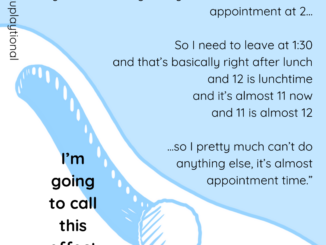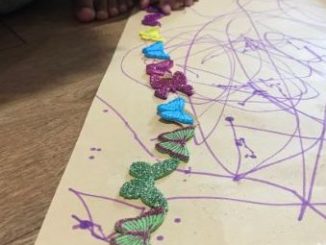I have a guessing game called, “Which of these ‘behaviors’ is actually a sign of developmentally appropriate schema play in toddlers and babies?”
(if you don’t know what schema play is, I’ll explain in just a sec 😉 )
Okay, so here are your options:
a) Throwing toys, even after the adult has told the baby/toddler not to throw
b) Spitting saliva, or putting water in the mouth and then spitting it out
c) Mashing up food in your mouth and then opening your mouth to show it to somebody
d) Dumping out bins of toys that your grown-up just put back in the bin
e) Hiding from grown-ups (under blankets, in toy box, in a cupboard…)
Which of these, when done by babies and toddlers (and even preschoolers), is probably a sign of a play schema rather than being a sign of “misbehavior”?
Hold your guesses in your mind and let me explain what a play schema is. A schema in general is like a collection of knowledge or facts, organised into one group. A play schema is when children gravitate toward the same type of play over and over again so that they can begin collecting enough facts to construct knowledge about something in the world.
It’s basically how kids learn all kinds of initial things about the sensory world around them.
Was your guess that of all the examples above, none of them were “behavior” in a vacuum but that *all* of them could be play schemas? If so, you were spot-on!
a) Throwing things is part of the Trajectory schema. It’s how kids figure out the properties of physics that apply to when things are thrown. How far will it go, how much internal muscle force does it take, how will things ricochet when they land, what kind of a sound will it make…etc? If you, an adult, tossed your keys onto the dining room table, you would have an innate sense of all of those things and also how all of those things would differ from the experience of tossing a balled-up sock into the laundry. This is the stage where children learn this.
b) Spitting is part of the Containing schema. Containing is all about, well, putting things in and out of containers. And as weird as it sounds, your mouth is totally a kind of container. How much water is too much to fit in the mouth before it dribbles out? What about filling it to bursting and then exploding it all everywhere? How do the muscles inside this “container” work together to expel their contents powerfully?
c) Mashing up food in your mouth is part of the Transformation schema. Transformation is all about how things change into other things by various physical processes. Kids exploring the Transformation schema often want to mix things together, make “recipes”, smash things up and mix them with water and see what they look like, and so on. And your mouth is a handy tool for that kind of mashing too.
d) Dumping is part of the Containing schema as described above. Putting things in the container and then back out of the container is all Containing!
e) Hiding is often part of the Enveloping schema. This focuses on exploring how things can be hidden (including your self as a thing). Putting letters into envelopes, putting small toys into boxes that can be entirely closed, wrapping toys in blankets, throwing things away in the lidded trash can, all of these are explorations of Enveloping. It involves exploring concepts like: what types of enveloping materials are see-through and what types aren’t? What if only part of the object is hidden vs all of the object? Later, they will be able to walk into a room looking for their shoes, see part of a shoe peeking out from under a pillow, and deduce that the whole shoe is there, because their brain learned during Enveloping that the part is part of the whole.
Okay, so an important thing to note is that just because we adults can recognise that a particular type of play is part of a developmentally appropriate schema DOESN’T mean we have to just allow the child to ruin or destroy something. We can know that our child is acting in a developmentally appropriate way and still also know some knowledge that our child doesn’t know.
For example, we may know these two facts at once: “My child is engaged in developmentally appropriate Trajectory play, which explains why they want to throw that object. AND, I know that that object is a 2 pound dumbbell that could hit the dog and injure it very badly, or hit the wall and break right through it.”
Knowing that it’s developmentally appropriate just informs our reaction. It means we don’t have to get flustered, angry, or worry 20 years down the road that this means our baby will throw dumbbells at people and that they won’t “know it’s not okay”.
Knowing that it’s developmentally appropriate informs our ability to stay calm as we intervene, knowing in our heads, “It’s totally normal for you to do this. It makes perfect sense that you want to do this. You are doing a thing your body needs to learn. I will help you do it in a way that’s safe for everyone.”
Trajectory-exploring toddlers need things that are safe to throw. Fill the environment with things that are safe to throw! Socks, stuffed animals, pillows, feathers, loofahs, sponges, scrunched-up paper. When my kid went through hardcore Trajectory phases, for awhile that was all the toys he had in his room!
Containing-exploring kids need things they can put in other things. Set them up with a dozen little spoons, scoops, and cups in the bathtub. Let them put everything they own into their shape sorter toy. Give them access to the plastic cups or the pots and pans in the cupboard.
Transformation-exploring littles need to mix weird things together and see what happens. Let them play with the old soaps that you bought and then didn’t like the scent of, or mix together different colors of ultra-washable paint (50% washable paint, 50% dish soap) in the backyard, or mix together flour and water, or whatever ingredients you feel OK about them using. If you have personal or cultural strong feelings about use of food as a play tool that you can’t get around, then give them play-doh and sand and whatever other non-food ingredients you can find.
Enveloping-exploring kids are probably going to hide some of your stuff. If it’s super important, make yourself a note or set yourself a reminder to hide the stuff that’s truly important (before your kid hides it from you!) You can even dive into it with them — find different kinds of fabrics you can use to cover things up and hide them!
There are more schemas than just these that I’ve introduced today, but this was already getting super long, so I decided to break it up. Look for the next one soon…



